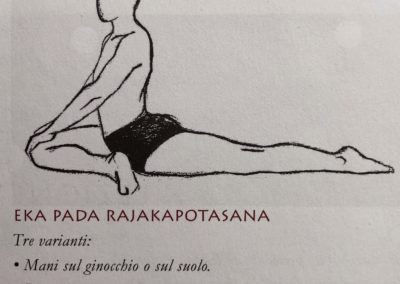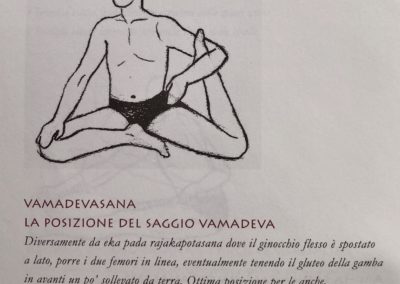Among the practices that come to our aid in this period of partial immobility, there is that of the royal pigeon, in the simplified variant, with the leg remaining elongated.
Eka Pada Rājakapotāsana
“It deserves to be included in the daily series of asanas, because it helps to straighten curved backs and free the hip joint, so threatened by our way of life.”
Andre Van Lysebeth [1]
Eka Pada Rajakapotasana can be easily inserted in the dynamic heating before being practiced in static form. The way we like to propose, heating in some’ “intense” It is in the transition between the dog that looks down and lunge.
Manu usually offers as well:
- the position of the dog that looks down to bring one foot in his hands, imagine right; at that point we will have the right foot next to the right hand and, the other side of the left hand. The left leg can rest the knee.
- From here, far “migrate” the right foot towards the left hand, facilitating the descent of the right knee towards the right hand; of course, the basin will remain very relieved given the highly angled position of the right knee, variant that helps not only the hip joint but also a work on the rear of the leg and on the corresponding buttock.
- From there, slowly increase the bending right knee to gradually move the foot toward your pelvis: each may decide to which closure requires, both for the type of work sought is based on your ability. What will change, and that should be considered, It will be the positioning of the right thigh with respect to the pelvis (more displaced outwards or rather perpendicular interrogating more balance).
- The hands will be active and will support your upper body while your back leg, stretched and taut, with the sole of the foot facing upwards and not to the side – as accurately indicates Van Lysebeth in its description – continues its work of “to slide” back aided by the weight of the body, partly supported by the hands-arms, to go to gently accompany the pelvis to the ground.
What you can do, At first, It is to pass in a dynamic way by the sinking dog doing then migrate the foot towards the opposite hand, then return, repeating with the other leg and maybe spacing out this step with other āsanas useful in this small Vinyasa, like the bench-sentinel or the transition to a three-legged dog with the opening of the left (lifting one foot to the sky by the dog looking down, and making “fall” the knee-leg on the opposite side – what Manu, with the children but now also with adults, who loves “the dog peeing”… clear, no?).
When you are ready you can think of to try to inhabit the static position.
- Picking up where we had arrived can be useful, if not necessary, Shim the basin so you can experience the “thrust” Ground relaunched from sliding leg back. Initially for people like Manu has a very stiff back, It will be unthinkable to realize the position in its dorsal extension, possibly freeing the hands as support.
But the question is always: what we want to work?
We meet the difficulty in small doses.
If the first problem are the legs or, However, It is on “jetl was” the legs that we want to work, We can keep your hands on the ground and focus on the action of the rear leg; keep breathing and, gradually, move the support of the hands on the knees in front: that in itself it becomes more richiestivo for the back as it increases the dorsal extension, as well as more challenger balance.
However even the hands placed on the ground can be very useful to give a direction to the back: maintaining the neighboring and lower blades and playing a little bit on the slight bending of the elbows and then lay them again, we feel retropulsion and the resulting "explosion" of the chest forward, as the real pigeon position requires.
What hands are on the ground or on the knee, at that point it might be useful to achieve a more simple variant, ie the forward bending, where the torso “spreads” Thigh-shin (depending on how the leg is positioned in front of) and arms that glide back to the ground. You'll find you can do it all!
From interesting here also move with the torso in the inner space to the knee flexed, ie in our case on the left: Another interesting movement. Returning then to reposition the center and use your hands firmly to lift your torso, or better: to extend! You will feel a big difference!
From here there are many possible other variations:
- gradually try to raise a hand at a time to increase the pressure of the ground area;
- bring the two arms outstretched to the side, with palms facing forward, maintaining the shoulder blades together and lowered so as to advance the chest;
- raise your arms to the sky holding her hands in prayer, increasing the dorsal buckle;
- finally you can join your arms extended in front of the chest with his hands in prayer without bending your torso: Hence the difficulty of the lift arms is amplified by the instability of the base and therefore the need for continuous adjustments (move your hips to the ground, keep the back extensors and the open chest with arms raised forward).
The practice of these variants allows a tension release at the level of the legs also given the increased blood inflow in the pelvis area, in addition to the benefits at the level of back injury if already appointed. Our Albiji is usually propose these variants!
Another possibility is to try to do the pose “full” that would provide for the flexing of the rear knee to bring, with time and with the help of hands, his foot to touch the head, with the back arched to meet him.
This variant is definitely not suitable for everyone and could be interesting, with time, work to be able to grasp the foot behind, flexing the knee, for a more intense work-ileum psoas level (hold it in your hands or catch him in the elbow); then you could go in the direction of the call Vāmadevāsana variant which requires that the rear foot is in ports “to touch” the foot of the front leg, taking care to keep the front thigh-femur exactly perpendicular to the dock.
B.K.S. Iyengar describes it well in his text [2].
In addition to the benefits already mentioned by Van Lysebeh, B.K.S. Iyengar sostiene:
“These rejuvenated positions the lumbar and dorsal regions of the vertebrate column. They exercise the muscles of the neck and shoulders; the various movements of the legs strengthen the thighs and ankles. The increase it blood circulation in thyroid, in parathyroid, in the adrenal glands and gonads increases vitality. Moreover, these positions stimulate circulation around the pubic region healthy keeping. These asanas are recommended for treating disorders of the urinary system and to control the sex drive.[3]”
Adding to Vāmadevāsana:
“This asana relieves pain, care stiffness in the legs and maintains healthy genitals. It also tones the spine and improves digestion.[4]”
For clarification on the proposed sequence, albeit with some differences, point This link
After having practiced both dynamically and as a static position, It could be useful to take some steps in Vinyasa already described and then continue with one of the other positions:
Bhujaṅgāsana, Cobra
Gomukāsn, the position of the muzzle of the cow.
Whichever you choose?
________________________
[1] From Lysebeth Denise e Andre, My Yoga Exercises, Mursia Publisher, 1980, p. 147
[2] B.K.S. Iyengar, Theory and practice of Yoga, Ohara, 2003, pp. 305-307
[3] ibid, pp. 339-345
[4] ibid. p. 307
[5] pictures from Walter Thirak Ruta, God is Happiness, Editions Pramiti, 2011, pp. 194-196



